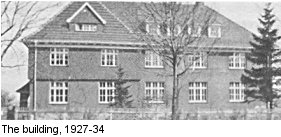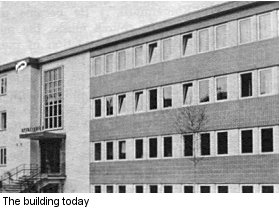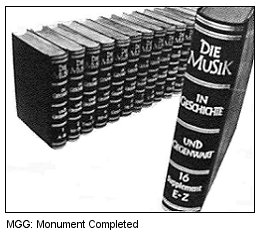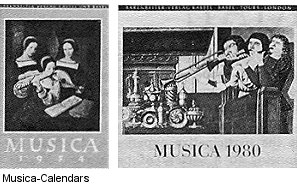
MadAminA! Feature
Baerenreiter: The House Of The Bear And Star
One of the giants among the world’s music publishers, Baerenreiter is also one of the youngest of Europe’s great music houses. This fact makes the West German company’s stature unrivalled in the industry and serves as impressive testimony to the imaginative vision and vigor of its founder and directors. What follows is a capsulized history of a remarkable chapter in music and communication.
Karl Voetterle was born in Augsburg on April 12, 1903. Before he was 21, he ran a book shop and supplied vocal and choral music to youth groups and others involved in music-making as a hobby. His credo was coined by Goethe: “to think and to do.” Thinking and doing became the principal motifs of his life.

Voetterle’s taste and judgment were already in evidence in his youth. He collected the songs which were to become the very first Baerenreiter publication under the title “Finkensteiner Blaetter”. An artist from Munich designed the first logo. It showed a young man riding a bear underneath a small star. The year was 1923, but the “official” establishment of the new enterprise had to await the 12th of April, 1924 and Karl Voetterle’s coming of age. His deepening interest in amateur music-making led him to new dimensions. He associated with music educators and inquired into their needs and preoccupations. (Today the Baerenreiter division, Gustav Bosse Verlag, is one of the most active publishers of music education-oriented material in the German-speaking world, originating the internationally successful “Kindermusik”.) He became profoundly involved in church music, the most generative force in the propagation of music throughout the ages. (Today Baerenreiter still publishes the periodical, Musik und Kirche, devoted to the entire gamut of liturgical music.) As a natural outgrowth of Voetterle’s early activities, he became more and more interested in practical musicology, the art of making the music of antiquity available in authentic editions for the most dependable contemporary performance practice. (In addition to the critical editions which are used by performers and scholars throughout the world, today’s Baerenreiter catalogue contains the greatest series of collected works under any publishing roof. Included are the collected works of Bach, Berlioz, Liszt, Mozart, Schubert, and Schuetz, all in splendid new editions; such monuments as the Hallische Handel-Ausgabe, the Berwald and Janacek works, and such older collections as the works of Gluck, Schein, Spohr, and Telemann.)

Three years after its establishment, the Baerenreiter catalogue boasted some 200 publications. Karl Voetterle’s fascination with pre-Bach music lent a hitherto non-existent dimension to music publishing, putting together such composers as Lasso, Isaac, Dowland, Pachelbel and Tunder. The little premises in Augsburg no longer sufficed. In 1927, the bear lumbered northward and a new star shone over a new house in Kassel. How that house prospered and grew is handsomely illustrated in Voetterle’s autobiography, Haus unterm Stern, and chronicled in an extraordinary publication, Baerenreiter-Chronik, 1923-1973. Both works reveal not only the achievements of the founder, but also his vision, his lifelong dedication to his art, and his humanism and compassion. Much later in his life, when the ravages of war gave birth to a generation of Sisyphean men, he was to write in his diary: “Stone upon stone, that’s the whole secret. My father was a mason, and I learned it from him … Devotion – out of insight, enthusiasm, or love – guarantees results . . . Trust, given to me by others, was the founding asset of the Baerenreiter-Verlag.”

One of the first major investments of the new quarters in Kassel was the print shop. It became the founding stone for a rapidly developing enterprise of musical scholarship, research, education, publication, and communication. By 1929, the mail-order division, which handles music from all publishers, was established. By 1932, the Baerenreiter catalogue began to encompass the present as well as the past. The first contemporary composer to join the ranks was Hugo Distler (1908-1942). (The roster today includes the works of Theodore Antoniou, Guenter Bialas, Rudolf Kelterborn, Giselher Klebe, Ernst Krenek, and such younger composers as Nicolaus Huber, Ulrich Stranz and Manfred Trojahn.) In 1942, Voetterle conceived of the preparation of the most comprehensive music encyclopedia ever undertaken in any language and secured the editorial services of Friedrich Blume for Die Musik in Geschichte and Gegenwart, world-famous “MGG” which was to occupy a prime role in the Baerenreiter publication program for over three decades. The Baerenreiter-Bote, a courier of the firm’s output, reports that music, periodicals, collected works, and books continued to appear even in the darkest days of World War IL And then, during the night of March 9, 1945, two months before the War’s end, almost all of Baerenreiter went up in flames during the final bombing of Kassel. Had it not been for the establishment, during the previous year, of Baerenreiter-Verlag Basel (with the help of the great Swiss musician and philanthropist, Paul Sacher), it is questionable if enough could have been salvaged to assure survival. But the tenacious determination of Voetterle and his colleagues, along with the help of many American friends such as Otto E. Albrecht, enabled the rebuilding of the house. The logo’s enlarged star glimmered over the indestructible bear.

The bimonthly Musica became one of the leading music periodicals in the German language. By 1952, Paul Henry Lang was to write: “We can now safely affirm that MGG will be the musical vade mecum of a generation to come.” The “Musica-Calendars” became a favorite Christmas present, and over 700 prints of paintings with musical subjects have been published. In an unprecedented publishing collaboration, Baerenreiter joined with the G. Henle-Verlag in making both scores and performance material available to works by classical masters in new critical editions. A record division lent an entirely new stratum to the communications spectrum. The annual chronicle, Das Baerenreiter Werk, was established to report on the manifold activities of Baerenreiter and its affiliates. (It never omits a chapter on the “Mitarbeiter”, the colleagues whom Karl Voetterle always regarded as the firm’s most valuable natural resource.) London joined Basel as the second foreign branch office (now known as London/Hitchin). France followed suit in 1962 with Edition Baerenreiter, now located in Tours.
Karl Voetterle died in October, 1975, at the age of 72. It is sadly noted in Das Baerenreiter Werk that Friedrich Blume, editor of MGG, passed away only a few weeks thereafter. The legacy they established is imperishable. As always, Voetterle’s chief interest had been in human resources, and the Baerenreiter “bench” was strong and deep. Then as now, Wolfgang Matthei was executive director; Dr. Wolfgang Rehm director of publications: Wolfgang Timaeus in charge of the opera and orchestra division; Gerhard Littmann in charge of sales; daughter Barbara Scheuch-Voetterle on the board of directors. They, with a close-knit group of department heads and co-workers, keep up the imaginative planning and formidable output of a firm which has enriched the musical and cultural awareness of the western world.
MadAminaA! Quick Index
principal news stories | feature stories | encounters
words n’ verse | editorials & commentary
© by Music Associates of America. All Rights Reserved
music associates of america // 224 king street // englewood // new jersey // 07631